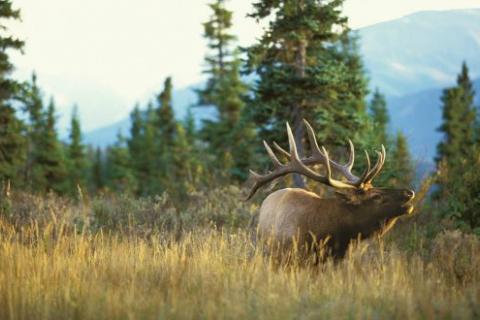
Can you tell a bark from a bugle? A cow mew from a cow moose? Put your elk hunting ear to the test with this quick quiz. Click each photo to listen to the associated sound or vocalization. Be sure to record your answers and click the link at the bottom of the page to find out your score!
A huge thanks to the Rocky Mountain Elk Foundation for providing these awesome elk audio clips!
1. What is this elk vocalization?
A. Parting Grunt — sound a bull frequently makes dismounting a cow he’s just bred.
B. Tending Grunt — sound a bull makes while herding cows straying from his harem.
C. Cow Mew — the sound often made by a cow elk staying in contact with a calf that’s out of it’s sight.
D. Donkey Bawl — sound a bull in full rut often makes at the end of a bugling sequence.
Elk photo copyright by Denver Bryan / Images On The Wildside 2016
2. What is happening here?
A. Bull is breeding a cow.
B. Bull is taking out frustrations battling a small Ponderosa Pine.
C. Two bulls are fighting over receptive cows.
D. Two bulls are sparring to establish dominance as the rut approaches.
3. When would you use this sound in your calling sequences during bow hunting season?
A. To challenge a satellite bull.
B. To cover avoidable noise during a stalk.
C. To try to reassure a wary bull that all is well.
D. All of the above.
4. This is another vocalization of the cow elk. When would you use it to entice a bull?
A. When the bull has busted you in heavy timber and you want to stop him for a last ditch shot.
B. Never. It’s a warning bark that will put every animal in earshot on alert.
C. When a yearling calf has wandered between you and the bull you’re after.
D. At the start of every bugling sequence.
5. What is the most important thing to remember when using this elk sound in your calling at any point in the season?
A. It can be a high-risk call because it’s loud, and you may have a bull very near. Plus, hard-pressured bulls may clam up as soon as they hear it.
B. It’s always the highest percentage call to go with. You’ll get a response almost every time you use.
C. It’s really the only elk sound you ever really need to learn.
D. The only time you’ll ever hear a bull make this sound is in the dark.
6. When you’re hunting with a companion and you’re hiking in before daylight, you hear an elk make this sound, what’s the first thing you should do?
A. Take off in that direction on a trot.
B. Throw up your rifle and shoot.
C. Stop; slowly separate and wait silently to see if the animal will do it again so you can get a better fix on its distance and direction.
D. Immediately respond with the exact same vocalization.
7. How much do cows talk?
A. Very little, and you should cow call sparingly at all times.
B. Cows, especially in a herd are mewing nearly all the time, so it can’t hurt you to cow call nearly constantly while you’re moving.
C. Cow calling is done in isolation, when they are away from the herd only and looking to rejoin the herd.
D. As in all calling, you need to tread carefully and determine what’s getting response from the bulls on any particular day.
Ready to see how you did? Click here to open the answers.
Your Rating:
6-7: Wapiti runs in your blood — a trophy bull is in your near future — and you ought to think about entering some calling contests, too.
4-5: Better than your average hunter — with just a little more practice you’ll have every bull on the mountain running to you.
2-3: Needs work—get out there and listen, then practice, practice, practice.
<2:Ummmm; hire yourself a good guide and let him (or her) do ALL the calling.
- 17076 views

